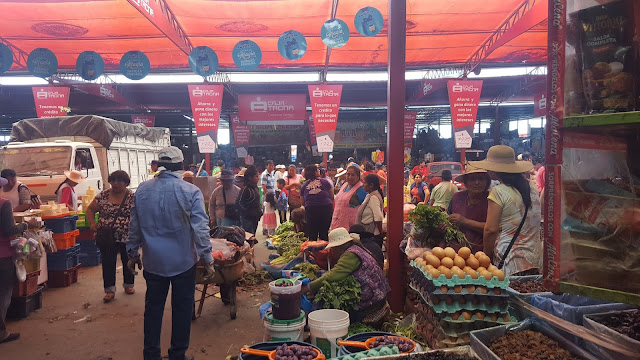Safeway has been ruined for life
Every Sunday, post a too-early (in my opinion) morning mass, two community-mates hop onto the #35 bus and head up to the center. It’s about 45 minutes from our house to the market, plenty of time for me to try and wake myself up before entering into the chaos that is Mercado Grau.
The first time I visited the market, I remember only an overwhelming sensation of noise and activity. Picture stalls and stalls with products stacked to the ceiling, stands with fresh veggies overflowing on the tabletops, people yelling the prices of their wares.
Before Peru, I could not have told you how many pounds were in a kilo. I definitely couldn’t have told you how many kilos of potatoes you might need for corn chowder or how many soles (Peruvian currency) of cinnamon you might need for the week— I’ll tell you now, it’s a lot less than you think. Buying fresh produce is a challenge. It requires so much more planning than a quick trip to Safeway where you pop whatever looks interesting into your cart or basket. You need to know quantities or you might find yourself lugging a ridiculous amount of pounds of produce throughout the market —obviously, shopping carts are not something you’ll find easily.
 |
| The meat section is often the section to be feared for many new JVs. |
 |
| Grau doesn't just sell produce! |
Going to a market where there are no barcodes, where haggling is a common occurrence, and long lines are replaced by shoving crowds has changed forever the way I view the purchase of food. I recently walked into Plaza Vea, Peru’s version of Walmart, and was surprised at my discomfort. Everything was organized, it was easy to find the aisle for coffee or household goods. No one cut in line to get their 2 kilos of rice. I didn’t have to try and haggle down the price of produce with a new casero (merchant) who didn’t know me. But with all of this organization, there was also no life. I stepped into the “fast lane”, for shoppers who had less than 10 items and found myself saddened to see everyone staring at their phone as they inched forward at an agonizing pace. Where were the wayward tomatoes rolling across the floor? Where was the cutting in line? Where was the yelling of “casero, casero”, as someone tried to catch the attention of the stall owner?
 |
| It's a ghost town in the afternoon hours |
The relationship that caseros (merchants) have with their caseros (customers) is a deep and dependent relationship. That's probably the reason the word is used interchangeably for both merchant and customer. The caseros' (merchant) relationship with their food is likewise much deeper than any employee at Plaza Vea might have with, let’s say, a basketful of apples. While both are earning their livelihood, there is a symbiotic relationship that a casero has with his produce. These are products my casero has physically handled, has himself haggled and bartered with other merchants to now display in his stall. In places like Mercado Grau, we have not lost the aspect of relationship, of interacting with live, human beings for our produce. Even with the disorganized and erratic service, there is something supremely comforting in knowing that the familiar faces of our vegetable casera or dry goods casero will be there to greet us every Sunday morning.






Comments
Post a Comment